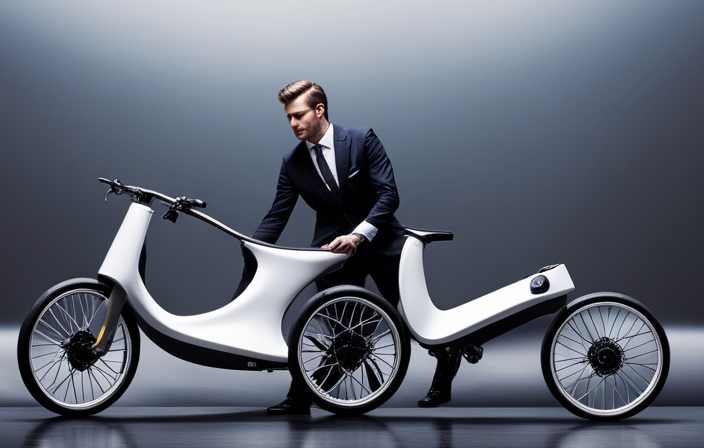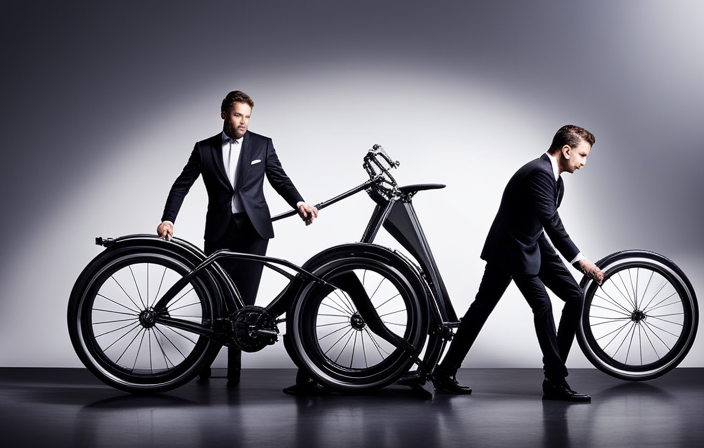Get ready to give your electric bike the spa treatment it deserves! In this guide, I’ll walk you through the step-by-step process of washing your electric bike to keep it looking and performing at its best.
We’ll cover everything from gathering the necessary supplies to protecting your bike with a layer of wax.
By the end, you’ll have all the knowledge you need to maintain your electric bike’s pristine condition and ensure it continues to provide you with endless hours of exhilarating rides.
Let’s dive in!
Key Takeaways
- Clean the chain and gears regularly using degreaser and brush to remove grime and prolong the bike’s lifespan.
- Inspect and tighten loose bolts and screws regularly to ensure safety and optimal performance.
- Regularly inspect and adjust brakes, replacing worn brake pads and tightening cables if necessary, for optimal stopping power and control.
- Maintain the wheels and tires by removing debris, checking tire pressure, and inspecting rims for damage, to improve handling, efficiency, and tire lifespan.
Gather necessary supplies
Now that you know what you’ll need, it’s time to gather up all your supplies to give your electric bike a good scrubbin’.
When it comes to bike washing techniques, there are a few things to keep in mind.
First, make sure you have a soft sponge or brush that won’t scratch the surface of your bike. Avoid using abrasive materials that could damage the paint or components.
Next, choose the right cleaning products. Look for a bike-specific cleaner that is gentle on the bike’s finish and won’t harm any electrical components. Avoid using harsh detergents or solvents that could strip away protective coatings or cause corrosion.
Once you have all your supplies ready, you can move on to preparing the bike for washing by removing any accessories and protecting sensitive areas.
Prepare the bike for washing
First, make sure you’re ready to start by gathering all the necessary materials and finding a suitable location for the cleaning process. It’s important to have the following items on hand:
- Soft bristle brush: This will help you remove any stubborn dirt or grime from the bike’s frame and components without causing any damage.
- Mild soap or bike cleaning solution: Using a gentle cleaning solution will ensure that you don’t harm the bike’s paint or finish.
- Microfiber cloth or sponge: These are ideal for wiping down the bike after cleaning and for applying soap to hard-to-reach areas.
When it comes to cleaning techniques, start by rinsing off loose dirt and debris with water before applying the soap. Use the soft bristle brush to scrub away any remaining dirt, paying close attention to the chain, gears, and brakes. After cleaning, use a microfiber cloth or sponge to dry the bike thoroughly. This will prevent any water spots or rust from forming.
Now, let’s move on to the next step of rinsing off the loose dirt and debris.
Rinse off loose dirt and debris
To begin the cleaning process, it’s important to rinse off any loose dirt and debris from the bike, which can account for up to 80% of the overall dirt accumulation.
When rinsing, you have the option of using either high pressure or low pressure water. High pressure rinsing can be effective in removing stubborn dirt, but it should be used with caution to avoid damaging sensitive components such as the electrical system. Alternatively, low pressure rinsing can be a safer option as it reduces the risk of water penetrating into delicate areas.
Additionally, for those looking for eco-friendly cleaning alternatives, consider using biodegradable bike-specific cleaners or homemade solutions like vinegar and water. These options can effectively remove dirt while minimizing harm to the environment.
Moving forward, let’s discuss the next step of using a gentle detergent or bike-specific cleaner to achieve a thorough clean.
Use a gentle detergent or bike-specific cleaner
For a more comprehensive cleaning, it’s advisable to utilize a mild detergent or a cleaner specifically designed for bicycles. These bike cleaning techniques not only ensure a thorough wash but also help maintain the longevity of your electric bike.
Here are some eco-friendly bike cleaning options to consider:
-
Biodegradable bike cleaners: These cleaners are formulated to be gentle on the environment while effectively removing dirt and grime from your bike.
-
DIY cleaning solutions: Mix vinegar or lemon juice with water to create a natural, chemical-free cleaning solution.
-
Soap nuts: These natural soap nuts can be used as an alternative to traditional detergents. Simply soak them in water and use the solution to clean your bike.
-
Bike-specific cleaners: Many reputable brands offer cleaners specifically designed for bikes, ensuring safe and effective cleaning.
By using these eco-friendly options, you can clean your electric bike without harming the environment. These sustainable cleaning solutions help reduce water pollution and minimize your carbon footprint while keeping your e-bike in top condition. Additionally, maintaining your bike regularly can prevent costly repairs, making it a good time to consider expenses like maintenance and even ask, how much is ebike insurance to protect your investment. By adopting eco-friendly practices, you ensure both your bike and the environment stay in great shape for the long run.
Now, let’s move on to the next step and scrub the frame and components with a soft brush or sponge.
Scrub the frame and components with a soft brush or sponge
Gently scrubbing the frame and components with a soft brush or sponge is an essential step in washing an electric bike. This process effectively removes stubborn dirt and grime that may have accumulated over time, restoring the bike’s appearance to a sparkling clean and refreshed state.
To ensure the best results, it is crucial to use a soft brush that will not scratch or damage the bike’s surface. Additionally, applying a gentle detergent or a bike-specific cleaner will help dissolve any tough stains or grease. By combining the use of a soft brush and a gentle detergent, you can effectively clean the bike without causing any harm.
After thoroughly scrubbing the frame and components, it is time to pay special attention to hard-to-reach areas, ensuring that every part of the bike is thoroughly cleaned.
Pay special attention to hard-to-reach areas
Make sure you give those tricky spots some extra TLC, reaching every nook and cranny of your e-bike to ensure a spotless and gleaming finish. Cleaning hard-to-reach areas is crucial to maintain the optimal performance and longevity of your electric bike. These areas, such as the chainring, cassette, and derailleur, tend to accumulate dirt, grime, and debris, which can affect the overall functionality of your bike. To prevent water damage, it is important to use a soft brush or sponge to gently scrub these areas. Be cautious not to apply excessive force or use high-pressure water as it may damage sensitive components. Additionally, consider using a specialized bike cleaning product that is safe for electrical components. Once you have thoroughly cleaned the hard-to-reach areas, you can proceed to rinse off the soap with clean water, ensuring a pristine finish.
Rinse off the soap with clean water
Once you’ve given your e-bike a thorough scrubbing, it’s time to rinse off the soap with clean water, leaving behind a sparkling and refreshed ride.
To ensure that all the soap residue is removed, it is important to use the right cleaning techniques and water pressure. Start by using a hose or a bucket of clean water. Gently spray or pour the water over the bike, making sure to reach all the areas that were previously soaped. Pay special attention to hard-to-reach areas, such as the chain, gears, and brake calipers.
Adjust the water pressure accordingly, as using high pressure can potentially damage the bike’s delicate components.
Once all the soap is rinsed off, you can proceed to dry the bike thoroughly with a clean towel or air compressor. This will prevent water spots and corrosion, ensuring that your e-bike remains in optimal condition.
Dry the bike thoroughly with a clean towel or air compressor
To ensure a pristine finish, you’ll need to thoroughly dry your e-bike with a clean towel or air compressor, leaving it gleaming and ready for your next adventure.
When it comes to drying your electric bike, you have two options: using a clean towel or an air compressor. While both methods can effectively dry your bike, using an air compressor offers a few notable benefits.
Firstly, an air compressor can quickly and efficiently remove water from hard-to-reach areas, such as the chain, gears, and brakes. Additionally, the powerful blast of air can help dislodge any remaining dirt or debris, ensuring a thorough clean.
Furthermore, air drying prevents moisture from pooling, which can lead to rust or corrosion over time.
With your e-bike now sparkling clean and dry, it’s time to move on to the next section: clean and lubricate the chain.
Clean and lubricate the chain
For optimal performance, don’t forget to regularly clean and lubricate your chain. This is crucial in ensuring smooth and efficient operation of your electric bike.
To properly clean the chain, first, use a degreaser to remove any built-up grime and dirt. Scrub the chain with a brush to thoroughly clean it. Once clean, dry the chain with a clean towel.
Next, apply a high-quality chain lubricant to ensure smooth and quiet operation. Be sure to apply the lubricant evenly along the entire length of the chain. If you notice any rust on the chain, use a rust remover to eliminate it before lubricating.
Remember, a well-maintained chain will extend the lifespan of your electric bike and improve your riding experience.
After lubricating the chain, it’s time to check and tighten any loose bolts or screws, ensuring the overall safety and reliability of your bike.
Check and tighten any loose bolts or screws
After properly cleaning and lubricating the chain, it’s essential to check and tighten any loose bolts or screws to ensure the safety and reliability of your ride.
Regular maintenance is important for keeping your electric bike in top condition. Neglecting to check and tighten loose bolts and screws can lead to potential hazards and decrease the overall performance of your bike.
When tightening bolts and screws, it’s crucial to avoid common mistakes such as over-tightening, which can damage the threads or strip them. On the other hand, under-tightening can result in parts coming loose during your ride. To avoid these mistakes, use the correct torque specifications provided by the manufacturer and make sure to use the appropriate tools.
By taking the time to check and tighten any loose bolts or screws, you can ensure a safe and enjoyable ride.
Moving on to the next step, let’s discuss how to inspect the brakes and make any necessary adjustments.
Inspect the brakes and make any necessary adjustments
Next, take a close look at your brakes and make any needed adjustments to ensure they’re in proper working order. Brake maintenance is crucial for the safety and performance of your electric bike.
Start by inspecting the brake pads for wear and tear. If they appear worn down or damaged, replace them immediately. Check the brake cables for any signs of fraying or stretching, and tighten them if necessary. Additionally, examine the brake levers and ensure they’re properly aligned and functioning smoothly. If you notice any issues, such as squeaking or poor braking performance, it may be time for a brake adjustment.
Properly adjusted brakes will provide optimal stopping power and control. Once you’ve completed the brake maintenance, you can move on to cleaning and polishing the wheels and tires, ensuring your electric bike is in top shape for your next ride.
Clean and polish the wheels and tires
Take a moment to give your wheels and tires a sparkling makeover, ensuring they shine like a star in the night sky. Wheel maintenance is crucial for the performance and longevity of your electric bike.
Start by removing any debris or dirt buildup using a soft brush or cloth. Next, inspect the rims for any signs of damage or wear. If necessary, gently clean them with a mild soap and water solution.
Moving on to tire pressure management, check the recommended pressure range indicated on the sidewall of the tires. Use a reliable pressure gauge to ensure the tires are inflated within this range. Proper tire pressure not only improves the bike’s handling and efficiency but also extends the lifespan of the tires.
Now, let’s move on to the next step and protect the bike with a layer of wax or bike protectant.
Protect the bike with a layer of wax or bike protectant
Give your ride a sleek and glossy finish by applying a layer of wax or bike protectant to keep it shining like a star. This step in bike maintenance is crucial in protecting the paint and prolonging the lifespan of your electric bike.
Before applying the wax or protectant, make sure to clean the bike thoroughly to remove any dirt or debris. Once the bike is clean and dry, apply a small amount of wax or protectant onto a clean cloth and gently rub it onto the surface of the bike, focusing on one section at a time. This will create a protective barrier against UV rays, water, and other environmental elements.
After applying the wax or protectant, buff it off using a clean cloth to reveal a smooth and shiny surface. By taking this extra step, you can ensure that your bike remains in top condition for years to come.
Now that your bike is protected, let’s move on to the next step of storing it in a dry and secure location.
Store the bike in a dry and secure location
To ensure the longevity of your ride, find a safe and dry spot to store your electric bike. Proper storage is crucial for bike maintenance and preventing rust. Choose a location away from moisture, extreme temperatures, and direct sunlight. A garage or a shed with good ventilation is ideal.
Before storing the bike, clean it thoroughly to remove any dirt or debris that may have accumulated during your ride. This will help prevent rust and keep the bike in good condition. Once the bike is clean, place it in the designated storage area, making sure it is secure and protected from any potential damage.
Regularly repeat the cleaning process to maintain the bike’s condition, ensuring a smooth and enjoyable ride every time.
Regularly repeat the cleaning process to maintain the bike’s condition
After storing the bike in a dry and secure location, it is important to regularly repeat the cleaning process to maintain the bike’s condition. By doing so, you can ensure that your electric bike continues to perform at its best and remains free from rust and corrosion.
To maintain bike performance, start by rinsing the bike with a gentle stream of water to remove any dirt or debris. Then, using a mild detergent and a soft brush, scrub the frame, wheels, and other components, paying close attention to hard-to-reach areas. Rinse the bike thoroughly and dry it with a clean cloth to prevent water spots.
Finally, apply a thin layer of protective wax or bike-specific lubricant to the frame and chain to prevent rust and corrosion. Remember, regular cleaning and maintenance will extend the lifespan of your electric bike and ensure a smooth and enjoyable ride.
- Use a degreaser to remove built-up grime from the chain and gears
- Inspect the brake pads and adjust as necessary for optimal braking performance
- Check the tire pressure and inflate if needed to improve ride quality and efficiency
Frequently Asked Questions
How often should I wash my electric bike?
I recommend washing your electric bike every few weeks to keep it in optimal condition. After washing, dry it thoroughly with a soft cloth, paying extra attention to the chain. Use a bike-specific chain cleaner and lubricant for proper maintenance.
Can I use a pressure washer to clean my electric bike?
A pressure washer can be used to clean an electric bike, but caution is advised. It is important to use a low-pressure setting and avoid spraying directly at sensitive components. After washing, thoroughly dry the bike to prevent any water damage.
Is it necessary to remove the battery before washing the bike?
Yes, it is necessary to remove the battery before washing the bike. This is important for battery maintenance and protecting electrical connections. Water can damage the battery and its connections, so it’s best to remove it to avoid any potential damage.
What should I do if water gets into the electrical components of the bike during washing?
If water gets into the electrical components of your bike during washing, immediately stop and unplug the bike. Remove the battery and any other exposed electrical parts. Use a towel to dry the components thoroughly before reconnecting and testing.
Are there any specific cleaning products or techniques to avoid when washing an electric bike?
When it comes to cleaning an electric bike, it’s crucial to choose the right cleaning products. Avoid harsh chemicals that could damage electrical components. Also, be careful not to use excessive water pressure, as it can infiltrate sensitive areas and cause issues.
Conclusion
In conclusion, washing an electric bike is an essential maintenance task that should be regularly performed to keep the bike in optimal condition. By following the steps outlined in this article, you can ensure that your bike remains clean, protected, and ready for your next ride.
Remember to gather the necessary supplies, rinse off dirt and debris, use a gentle detergent or bike-specific cleaner, scrub the frame and components, clean and polish the wheels and tires, and apply a protective layer of wax or bike protectant.
By storing your bike in a dry and secure location, you can prolong its lifespan and enjoy many more rides to come.









